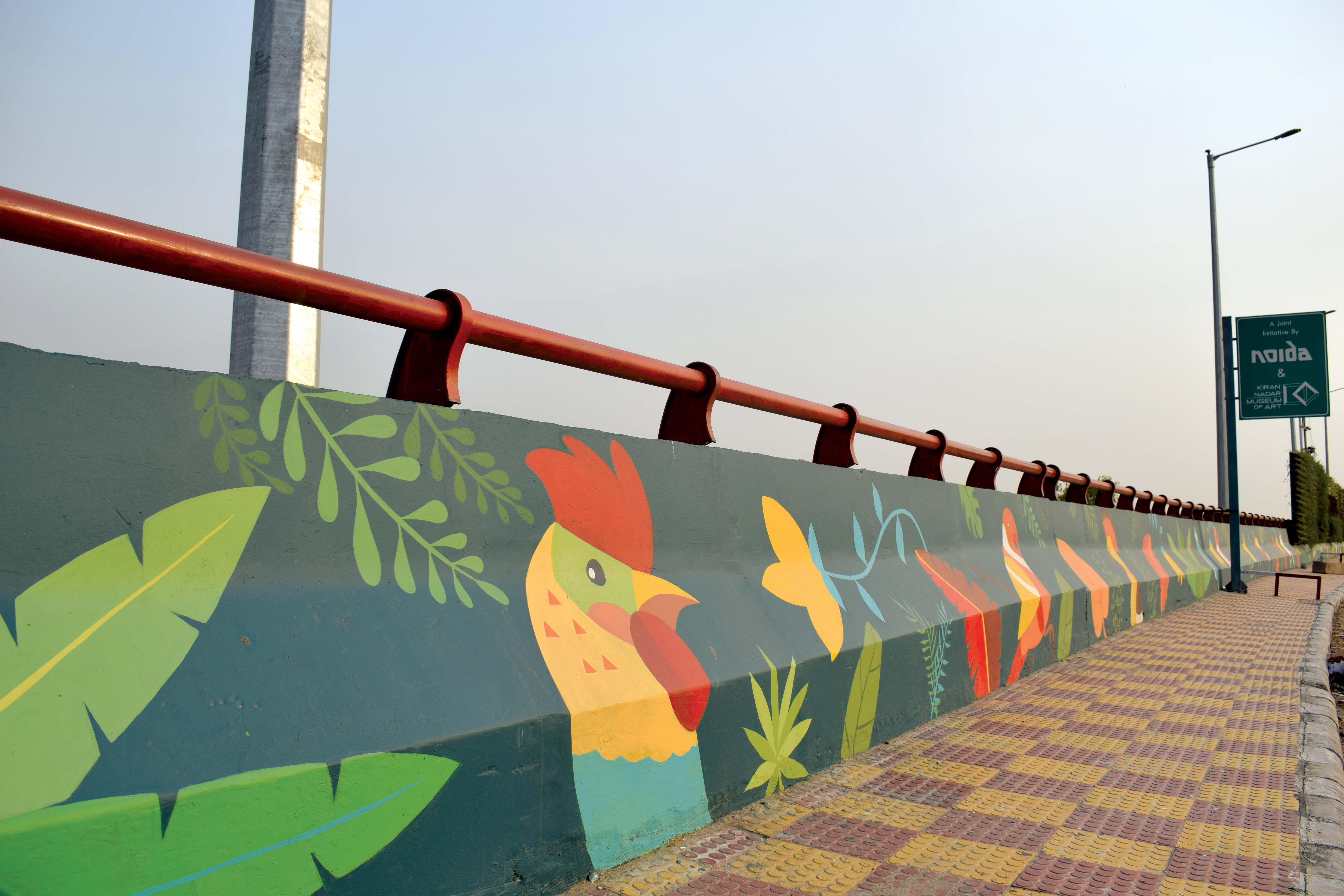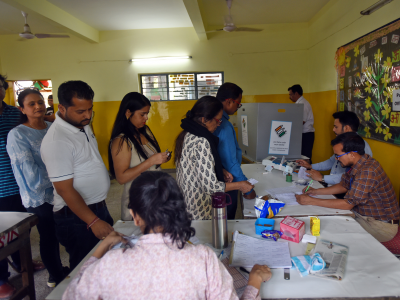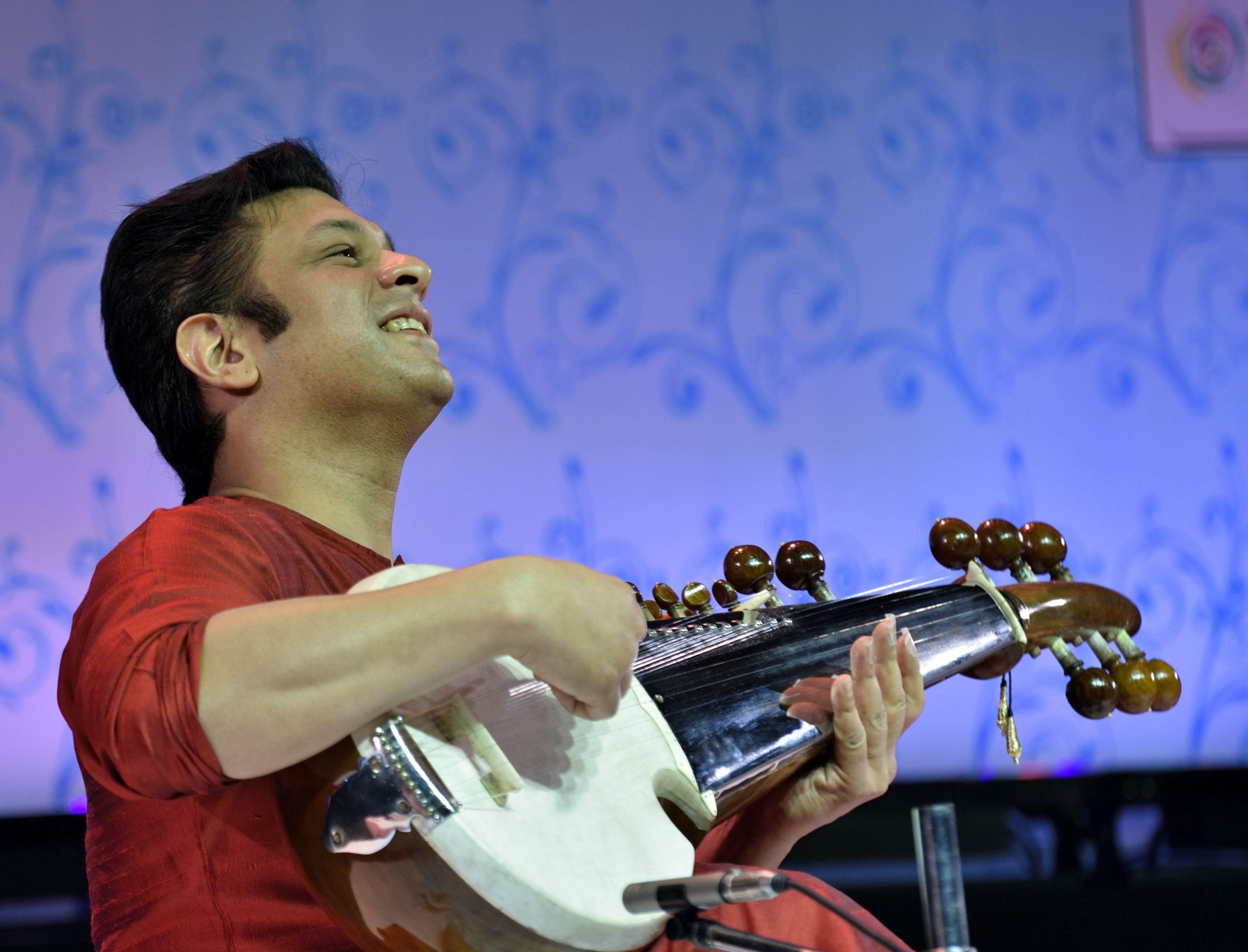Breaking out from the confines of galleries and museums to expansive public spaces, the creativity of artists is now brightening up entire walls, with help from civic authorities
Delhi-NCR seems to be on its way to being an aesthetic treat for tourists, commuters and residents. After the public art district at Lodhi Colony comes the new Noida-Kalindi Kunj bridge brightened up with Nature murals..
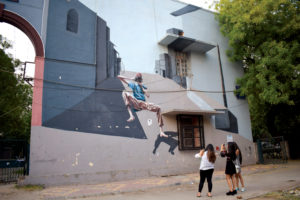
While Lodhi Colony was brightened up by St+art India in collaboration with the Delhi government, the bridge was done by Kiran Nadar Museum of Art (KNMA) in association with Noida Authority. Both non-profit organisations operate along similar principles of making art inclusive and getting more people involved in creating artworks.
This is in keeping with global trends — Asian governments pitched in to create the Busan Gamcheon Culture Village in South Korea and Taichung Rainbow Village in Taiwan.
KNMA painted Nature-themed murals on the New Kalindi Kunj Bridge and Rajnigandha Chowk. As the bridge over the river Yamuna leads to the Okhla Bird Sanctuary, the mural has dancing birds and the sound of music emanating from a huge gramophone on one side and the other side shows serene tableaux of the animal kingdom done in traditional Gond art. Another underpass in Noida too shows such artworks.
“Public works of art give a sense of belonging,” says Giulia Ambrogi, curator at St+art India, talking about Lodhi Art District. “Public art is like an open-air museum but with a different perspective. It’s not the regular art market. There is less focus on financial aspects and more about passion for dreamy and real expressions. If we go back 10-15 years, this was an underground movement—it wasn’t legit art. But slowly it gained momentum. In India, this is still an upcoming art.”
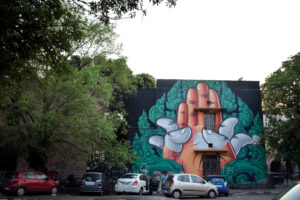
St+art India has been working on making art accessible to all since its first successful project in 2014—Mahatma Gandhi’s life-size mural on the walls of the Delhi Police Headquarters at ITO. “Art encourages peaceful gatherings. The streets have life,” adds Ambrogi, “and art in public spaces cuts across class, genders, disparities. It bridges gaps between people. Even the people who live on the streets have as much access to it as the people who go to see it in galleries and museums.”
When the wall by Polish artist NeSpoon was unveiled on Women’s Day, it was a public affair. Delegates of the European Union and the invitees all attended the function on the sidewalk as the neighbourhood joined in.
The colourful thematic walls of Lodhi Colony have been a social media craze in the last few months. Instagrammers, YouTubers, walk leaders have been buzzing about it.
On why Lodhi Colony, Ambrogi, the young Italian who has studied history of contemporary art, says, “The central location (it’s not a gated colony), is green, has sidewalks, is a government colony and the structures won’t be destroyed. The arty walls have a life of five to seven years.” While selecting the artists, Ambrogi tried to have an international and an Indian artist for each wall. “Asian Paints came in as a sponsor with the second work and they have been patrons in the real sense. Then embassies and consulates support the projects too. So, we are able to remunerate the artists.” The organisation also works on digitalisting handmade fonts which it sells to organisations such as Google.
The subjects chosen are social issues and themes people can relate to without upsetting any sensibilities. NeSpoon’s painting was about lacework, which is so popular with women in Europe. India also has its own crochet culture and the wall connects the two cultures. Then issues like climate change and use of plastic are highlighted on other walls.
Moving to other parts of Delhi, St+art India painted a 1-km-long boundary wall of Tihar Jail. “An inmate wrote a poem—Char Diwari (Four Walls) —that can now be read on this wall.” Ambrogi believes that all kinds of art needs to survive in unison. She landed in India in 2008 as part of a travelling exhibition and ended as co-founder of St+art India. Projects have been done in Hyderabad, Chandigrah, Goa and Mumbai,
There is a long way to go and the Italian curator has no intentions of going back soon. “It’s good to be here, in spite of the initial hiccups,” laughs Ambrogi.
Loving creativity
Public art spaces include people, but museums and galleries too are needed, as the artworks last longer there.
This is precisely why Kiran Nadar, founder and chairperson Kiran Nadar Museum of Art (KNMA), opened the first private museum in January 2010 in Noida. Now, there is one in Saket too. The museum began as a showcase of her private collection, “as I was aware of the dearth of institutional spaces”, elaborates Nadar. Now, there are over 6,000 works of art in museums in Noida and Saket. The collection highlights 20th century Indian painters from the post-Independence decades along with engaging with the different art practices of the contemporaries.
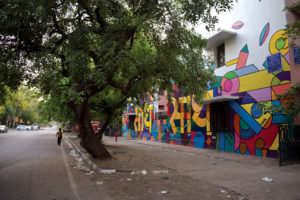
Since then, she has added much more to the portfolio of sensitising people in art. There are public art programmes, free workshops for children and adults in contemporary as well as traditional arts and more lately the painting of the Noida-Kalindi Kunj bridge. “People don’t visit art galleries too often, so the museum and artwork gets them involved in the world of creativity,” says Nadar. “Once art becomes a habit, people will visit galleries more often. We would like museums to be on the must-do touristy things in Delhi list. There is a lot of talent in our country. We have exhibitions for students at Shiv Nadar University and we want more and more people to recognise the upcoming talented young ones. We also want the traditional arts to have more exposure, so they shouldn’t die out.” KNMA also has a #chalomuseum campaign, in which a video highlights that there are 170 museums in India lacking visitors.
Perhaps the lack of interest is related to the price of the artwork as most good works need deep pockets. For the new artist, the struggle lies in exposure, survival and inability to reach the right markets. “This is why we have free workshops and encourage new artists. We are always on the lookout for fresh talent.”
Ins and outs of a global trend
Jason Bailey, writing in artnome.com, puts the new world trend of outdoor art in perspective. “For centuries, physical ownership of art was required to enjoy it. Art was a sign of wealth and power, and collecting art was about saying “I own this art.” With the increase in availability of the internet, we have seen a rise in social media consumption of art. Sharing selfies at museums and art fairs on social media signals your taste and sophistication without having to own physical artworks. And while a few dozen people may see the art you purchased at a gallery and hung on the walls of your home, hundreds to thousands of people instantly see the art selfies you share on your social profile. This has enabled art appreciation to be less about saying “I own this art” and more about saying “I like this art.”
The word of creativity and colours has its ups and downs, maybe it is dependent on political and socio-economic conditions, but for some it’s the world they want to share with everyone. In Bailey’s words, “I predict that museums, galleries, and auction houses will realize improving diversity/inclusion and focusing on the rapidly shifting intersection of art + tech is the key formula for increasing interest, engagement, and participation in the arts.”

